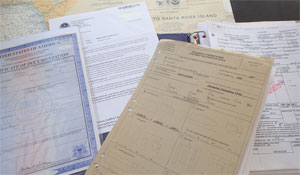Most of the more experienced power voyagers I work with have a system and a plan to look after just about every aspect involved in the management of their boats. The techniques they employ to track and monitor their equipment have been featured and discussed in this series of “Dial-In-Your-Trawler” articles.
Managing ship papers is one topic that I find particularly important for my brokerage clients who are new to the idea of owning a cruising yacht. This is even a subject I have lectured about in TrawlerFest seminars, and I have included the list of necessary documents as a class handout.
Everyone knows there is a lot of paperwork involved when it comes to purchasing, owning and maintaining a proper cruising yacht. I’ve been able to distill a lot of the wisdom I have collected from others, and we provide this as a service to our trawler buyers. This is an always-evolving collection of documents, but the intent here is to get you thinking about what you have, what you need and what path (should we call it a paper trail?) that will get your “docs” in a row.
 |
|
A custom ship’s stamp makes all paperwork more official. |
Those who are very well organized keep three-ring binders filled with hard copies of manuals and important documents — they also have electronic copies as backups. It is interesting that there are really two logical ways to organize ships documents: alphabetically, or in the order that best suits you. I’ve seen both styles; you simply need to use whatever makes it easiest for you to find what you are looking for when you need it.
To collect and assemble the necessary paperwork, we provide to our clients the accompanying alphabetical list comprised of the most common documents they are likely to have or will need to have aboard (see sidebar below). This list is good for both local and international travel. If your documents are all originals, I suggest you scan these to make electronic copies (PDFs) as well as color photo copies to keep in a safe place.
I hope you will consider my list of suggested ship's papers a solid start, but I understand there is always something to add. I welcome your comments if you have other documents to suggest.
 |
|
The papers pictured below are just a sample of the types of information you may need to have access to. Filing these in a binder keeps them safe and in one place for easy retrieval. |
Most power voyagers now carry a printer and paper on board. Arriving in a faraway place and then having to find a store to make five copies of a particular document at a dollar per page is annoying and time consuming. I know some vessel owners who will keep the originals in a safe place and then color photocopy and laminate key documents to keep in a binder on a shelf in the pilothouse. In fact, having an off-vessel home base with a duplicate set of your papers that can be relayed to you from family or friends is a good backup plan.
One neat idea I have seen a couple of trawler owners do for traveling internationally is creating their own ship’s stamp. They order a custom-made ink stamp with the profile of their boat, the name of their boat, their country’s official number and even their HIN (hull identification number), and have it ready for action. When they clear in and meet with immigration officials, they will stamp the documents that the customs officials stamp. By counter-stamping with their own ink impression, they add an air of ceremony and officialdom to the whole process.
In addition to providing the list mentioned previously, another thing we do is hand our clients a three-ring binder filled with clear pocket inserts that they can use to collate all of their own ship’s papers. We have reviewed what dozens of trawler owners include in their binders and summarize this for all of our clients so that they know what they should include and can insert the documents in an organized fashion. Presently, we provide more than 30 different documents for our clients to include in their ship’s papers binder.
 |
|
Even this Mexican sign directing newly arrived vessels to check in has a stamp on it. |
We pre-fill each transparent pocket with the title of the document on an otherwise blank sheet of paper so that they can put the actual document into the pocket where our placeholder page is inserted. For example, we will include a page labeled “USCG Documentation,” and that is where they will file their blue USCG Certificate of Documentation.
Having all of your important papers in the same place makes it easier to keep track of them. Many documents expire and need to be renewed, so it’s wise to have a one-stop location to remind you of what needs to be kept current. As with any organized system, there is a bit of time spent getting set up — a good rainy-day project — but the benefit of ready access whenever needed makes this a worthy chore to undertake.
Jeff Merrill, CPYB, is the president of Jeff Merrill Yacht Sales, Inc.- www.JMYS.com. He is a veteran yacht broker who provides individual attention and worldwide professional representation to buyers and sellers of premium brand, oceangoing trawlers. Merrill is active in the cruising community as a public speaker and writer and enjoys spending time at sea with clients. Jeff has written several articles for Ocean Navigator’s Power Voyaging column and is constantly looking for new ideas to improve and simplify the trawler lifestyle. If you have a suggestion or want to get in touch, please email Merrill at Jeff@JMYS.com.

